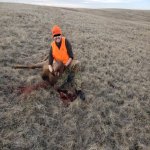I would say your first priority should be securing land access as fast as you can right now. Go out every evening after work and start asking.
Once you get access to land, do some e-scouting before heading out. You can find a lot of the areas you’re looking for before you even put boots on the ground. You’ll also be able to see building locations so you know what’s behind your target once you’re on the ground.
Layering will be the key. Until the snow flies you will definitely be walking. Some owners will open the gates to drive through in Nov depending on weather.
The ihunter app is pretty convenient, otherwise you can check out county maps (cypress).
If solo hunting and packing out, I recommend youtubing how to field dress animals using the gutless method. As this is your first year, I’m guessing you will only be going after whitetails. Also make sure you have hiking poles for longer packs out. Cheap ones can be found at costco.
Given that land is all private around here, you won’t be camping out and will be returning to your vehicle every day. Unless you’re down in a deep coulee you should have reception. You can drop way points on the ihunter app where your vehicle is and you’ll know where to return to in the dark. Keep your phone warm and leave it on airplane mode when you’re out.
You seem to know what to be looking for. Lots of dugouts around and the river so water is usually close enough anywhere you go. Good cover like stands of trees/bushes, tall grass around dugouts or in low areas and sage brush patches is a good place to start. If you know of any old homesteads, they’re usually over grown and good places for deer to hide out. When crops are still standing, especially corn you’ll find lots of deer in them.
First light and last light is the best time to spot them when feeding in the open or travelling back to cover but coming into November now, they will be getting more active and will be out all day when rutting. Deer will get up and feed periodically during the day none the less.
Carry a little more food and water than you think you need, stay dry and watch the wind.
Also, don’t forget that big game hunting is closed on Sundays here.
Once you get access to land, do some e-scouting before heading out. You can find a lot of the areas you’re looking for before you even put boots on the ground. You’ll also be able to see building locations so you know what’s behind your target once you’re on the ground.
Layering will be the key. Until the snow flies you will definitely be walking. Some owners will open the gates to drive through in Nov depending on weather.
The ihunter app is pretty convenient, otherwise you can check out county maps (cypress).
If solo hunting and packing out, I recommend youtubing how to field dress animals using the gutless method. As this is your first year, I’m guessing you will only be going after whitetails. Also make sure you have hiking poles for longer packs out. Cheap ones can be found at costco.
Given that land is all private around here, you won’t be camping out and will be returning to your vehicle every day. Unless you’re down in a deep coulee you should have reception. You can drop way points on the ihunter app where your vehicle is and you’ll know where to return to in the dark. Keep your phone warm and leave it on airplane mode when you’re out.
You seem to know what to be looking for. Lots of dugouts around and the river so water is usually close enough anywhere you go. Good cover like stands of trees/bushes, tall grass around dugouts or in low areas and sage brush patches is a good place to start. If you know of any old homesteads, they’re usually over grown and good places for deer to hide out. When crops are still standing, especially corn you’ll find lots of deer in them.
First light and last light is the best time to spot them when feeding in the open or travelling back to cover but coming into November now, they will be getting more active and will be out all day when rutting. Deer will get up and feed periodically during the day none the less.
Carry a little more food and water than you think you need, stay dry and watch the wind.
Also, don’t forget that big game hunting is closed on Sundays here.









































































